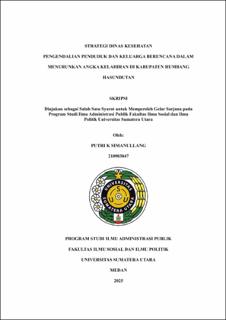| dc.description.abstract | The high birth rate in Humbang Hasundutan Regency indicates that the
strategies implemented by the Office of Population Control and Family Planning
(PPKB) have not been fully successful in reducing the birth rate. This is evidenced
by the region’s Total Fertility Rate (TFR), which remains high at 3.17. This study
aims to analyze the strategies implemented by the PPKB Office in efforts to reduce
the birth rate in the region. The research employs a qualitative approach with a
descriptive method. Data were collected through in-depth interviews, observation,
and documentation.
The analysis is based on Koteen's theory as cited in Salusu (2004), which
categorizes strategies into four types: organizational strategy, program strategy,
resource support strategy, and institutional strategy. The findings indicate that: (1)
the organizational strategy is implemented by expanding the coverage of family
planning services and establishing cross-sectoral partnerships; (2) the program
strategy includes direct and mobile family planning services, free contraceptive
services, and education based on local wisdom; (3) the resource support strategy
involves the management of BOKB funds, mobilization of field officers (PLKB), and
provision of infrastructure, although it remains limited; and (4) the institutional
strategy involves collaboration with the central BKKBN, local health institutions,
other relevant agencies, and the formation of family resilience groups as a means
of education and public participation.
The study concludes that the strategies implemented are relatively
comprehensive and adaptive to local conditions, yet several challenges remain,
such as limited funding, inadequate facilities, and low public awareness. Therefore,
a more integrated strategic reinforcement is needed to achieve sustainable
reductions in the birth rate. | en_US |


